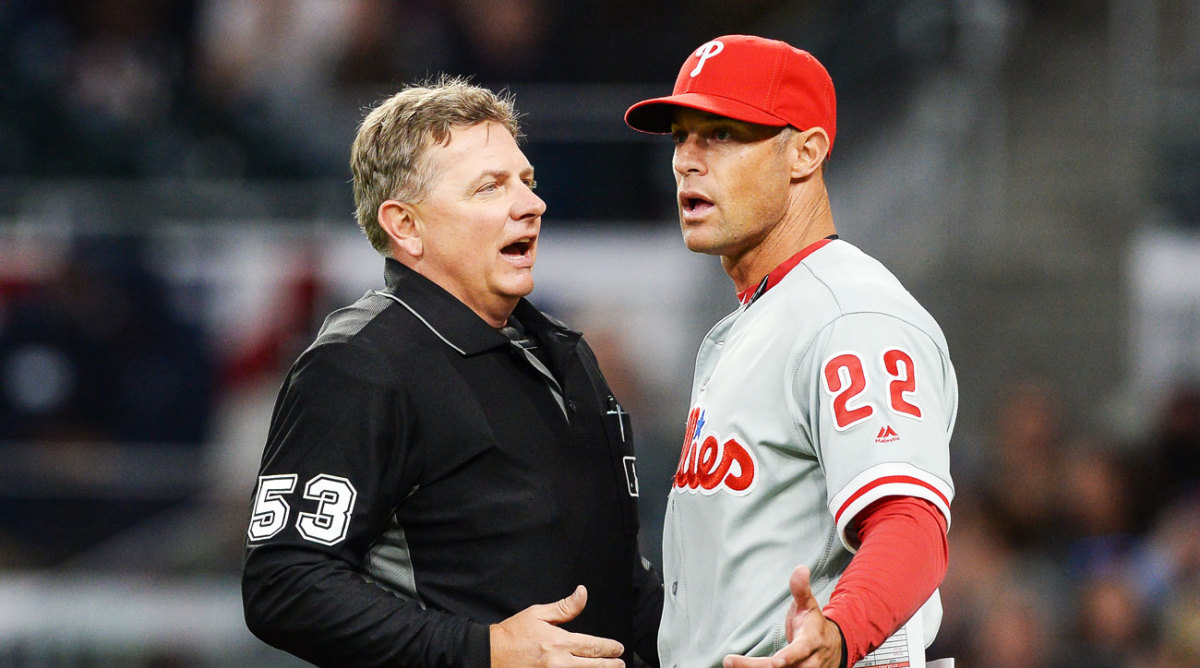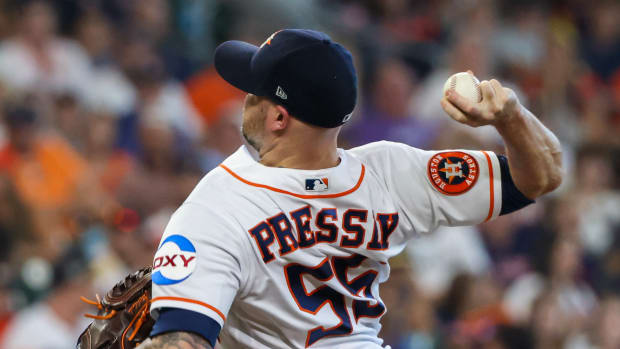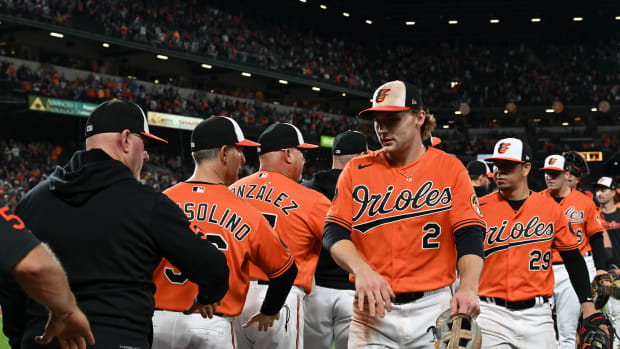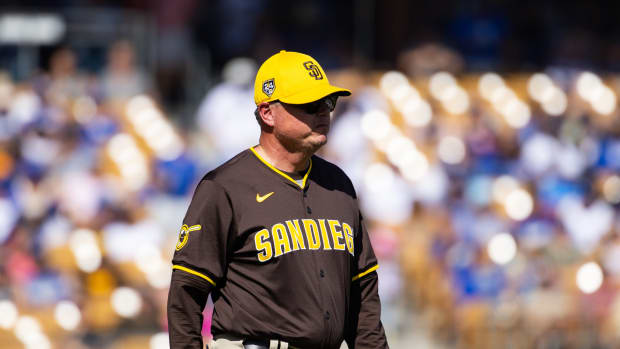Phillies Manager Gabe Kapler Is Off to a Brutal Start, But It's Just the Beginning of His Experiment

NEW YORK — Standing in front of a dozen members of the media in the visiting manager’s office at Citi Field, Phillies skipper Gabe Kapler took stock of a bizarre and controversial first weekend of play for his team and put the blame squarely on himself.
“My job is to stand up and be accountable for any of those mistakes and explain why I make the moves I make, and that’s an important [lesson] from the first three days,” Kapler said before Tuesday night’s game against the Mets. “There’s been some difficult moments, and there’s also been a lot of opportunities to learn.”
“Difficult moments” may be underselling it. Over the first three games of his big league managerial career, Kapler found himself enmeshed in messes of his own design. On Opening Day, he pulled starter Aaron Nola after just 68 pitches and 5 1/3 innings of scoreless work against the Braves, then watched as five relievers combined to blow a 5–0 lead and the game. The next day, Kapler burned through nearly his entire bullpen—eight pitchers in all—to secure the final 15 outs of a one-run win, Philadelphia’s only one this season. And in the series finale, he tried to put in a reliever who wasn’t ready because he hadn’t been told to warm up en route to using four more pitchers, and ultimately a position player, in a 15–2 rout.
It was that botched call for relief in the third game—when Kapler removed starter Vincent Velasquez in the third inning and waited for lefthander Hoby Milner to take his place, only to stand, confused, on the mound with his infielders as no one emerged from the bullpen—that has drawn the most attention. Speaking on Sunday to reporters, Kapler repeatedly described the strange scene as a “miscommunication,” and he stuck with that description on Tuesday. “When I got to the mound, I was surprised that [Milner] was not warmed up. But that’s my responsibility to make sure that doesn’t happen,” he said.
Milner stuck to that line as well while addressing reporters in front of his locker—the recipient of more media attention in one afternoon than most situational lefties get in entire seasons. “It was a miscommunication, that’s what happened, and we’re going to take steps in the future for that not to happen,” he said.
Exactly what those steps are remain unclear. Before the game, Kapler talked about new “bullpen guidelines” that he and the Phillies’ front office had come up with over the two days between Sunday’s debacle in Atlanta and Tuesday’s opener in New York to help guide his decision-making process. He didn’t provide much in terms of specifics as to what that entailed beyond “try to keep everyone healthy.” “I spent the last 48 hours digging into how to improve our bullpen usage and be really good at it going forward—really respect the arms, keep people healthy and strong, not overuse them, while still respecting how to mix and match and be creative with a very deep bullpen,” he said.
Walking that tightrope has been a significant challenge. Kapler’s propensity to play matchups earlier than most managers would and his disinclination toward letting starters go through a lineup a third time has resulted in him wearing out the path between the dugout and the pitcher’s mound. On Tuesday, he ended up using four pitchers to get the last seven outs of a loss. Ironically, he might have been better served by going to his bullpen earlier: Righthander Ben Lively worked five stellar scoreless innings but faltered in the sixth in his third time through the order, giving up a pair of runs on two hits that proved to be the difference in a 2–0 Phillies loss to the Mets.
Unlike his first few games, Kapler had plenty of rope for his bullpen on Tuesday thanks to a scheduled off day Sunday and an unplanned one Monday because of a snowstorm that postponed the series opener. What remains to be seen is how aggressive he’ll be with his relievers as the season goes on and he has to go several days at a time without breaks or reinforcements. Running through four or five pitchers a game or trying to create lefty-lefty matchups in the third inning simply isn’t sustainable over the course of a full season. That’s something Kapler acknowledged, noting that he had planned to lean on his relievers heavily in the first week because of the off days on the schedule.
“There’s no way we can continue the bullpen usage like we did because guys are going to be down,” Kapler added. “We understand now that, going forward, our bullpen usage is going to be changing a little bit.”
There was always going to be a learning curve for Kapler, whose entire managerial experience before this season consisted of 139 games at the helm of the Class A Greenville Drive in the Red Sox’ farm system in 2007. Its shape and height is potentially complicated by the fact that Kapler is, in no uncertain terms, an eccentric thinker. Consider his now defunct blog, in which he extolled the virtues of tanning your genitals and masturbating with coconut oil. Compared to that, a hyper-aggressive and analytics-driven bullpen usage may not be that far out an idea, but it’s clear that, after his first 72 wild hours as manager, Kapler is not exactly conventional. What is unclear is if he can be successful that way.
The modern bullpen now accounts for more outs than ever before in the game’s history, and its members are perhaps more talented than at any point in baseball’s past. Using it early and often has become an increasingly popular tenet of managing, and Kapler has embraced that strategy to its fullest. But it’s more of a living organism liable to screw up than a machine that will function flawlessly if operated in the right order. Kapler can try to get the best matchups in every inning or cycle through arms by the dozen, but the human beings those arms are attached to are prone to failure, injury or, if things continue to go south, rebellion. And even if the process is correct, there will be times where it doesn’t pay off; what’s up for debate now is if Kapler’s machinations increase the likelihood that things come crashing down on a regular basis.
Four games into the season, it’s too early to tell or judge. Things haven’t worked out well so far, though Kapler has been without two of his best or most veteran relievers in Tommy Hunter or Pat Neshek, both of whom are on the disabled list. There will be adjustments—or, in Kapler’s particular brand of business speak, “reading and reacting”—when things go awry, though for now, his players seem okay with the fluctuations. “I know mistakes happen and are going to happen,” Milner said. “We’re all getting on the same page. It’s a learning process for us all.” Added shortstop J.P. Crawford: “Everyone’s judging him off a few games, but we still have [158] more. Once everything changes around and we start winning, I’m pretty sure everyone will change their opinions on him.”
What will be consistent, Kapler insists, is that if there are games in which things do go wrong, he’ll hold court with players and reporters alike and accept responsibility for whatever takes place. “I didn’t expect the season would go over with no mistakes,” he said. “I didn’t expect that the season would go over with moves not being scrutinized at all. I expected that and I expect to be strong through those and be accountable through all the decisions and mistakes I make.” As a player, Kapler said, he would work through his failings at the plate by hitting in the batting cage until his hands bled. As a manager, he wants to embrace the same idea: “If things aren’t going the way you want them to go, you go prepare better, work harder, dig in, go grind.”
“It’s not how you start, it’s how you finish,” said Crawford, and for Kapler’s sake, he should hope that the season ahead of him is less rocky than the games already played. Otherwise, the quick hook he’s deployed for both starters and relievers might come for him come sooner rather than later, no matter how standup a manager he’s been.




































